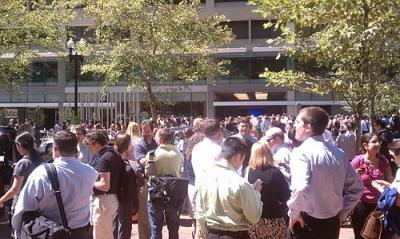THE GREAT VIRGINIA EARTHQUAKE of 2011. The most complete and informative blogging about the big earthquake that struck in rural Virginia Tuesday and made the East tremble comes from geologist Callan Bentley, of Mountain Beltway, one of the American Geophysical Union's blogs. Here's his initial post. Nothing out of the ordinary, Bentley concludes:
Note that this is an area where we’ve had earthquakes before, and will have earthquakes again (like the 2 aftershocks we’ve already had). Before anyone starts getting worked up about the SuperMoon or 2012 or some other such hooey du jour, please realize that this is merely the Earth doing what the Earth does. It’s a bit bigger than the usual east coast earthquake, and it was felt a bit more widely, but this is pretty much par for the course.
The fact that shocks were felt throughout the megalopolis, from North Carolina to Boston, was particularly startling to Easterners used to feeling the Earth move only in other contexts, if at all. That geographic sprawl made the quake seem worse than it was. Bentley explained why it ranged so widely:
East coast rocks are relatively old and cold, and thus more dense and more capable of transmitting seismic energy. California and the west, in contrast, has a higher rate of heat flow through the crust and so those rocks are more “poofed out” by being warm — they take up more volume, and so it’s harder for seismic energy to swiftly pass through them. Furthermore, in comparing the great distance that these waves traveled to a similar magnitude event in California, it’s worth keeping in mind that many of the fractures which would retard the transmission of seismic energy in the east have been sealed shut by mineral veins, while a lot of the west coast’s fractures are still relatively fresh. It’s hard for seismic energy to cross empty space.
Bentley posted again on the aftershocks, so called because (duh) they come after the Big One. At the time he wrote, it was not entirely clear that more and bigger were not on the way. In which case, he pointed out, the aftershocks would have become foreshocks.
Bentley also posted on the damage to his own condo. This was not the usual blog navel-gazing and whining, but a disquisition on how the small cracking patterns in his walls mimic much larger geological patterns, with photos.
Maybe Bentley's walls would be uncracked if his condo had been built differently. Several blogs speculated that the Virginia quake might be a wakeup call in the East, where earthquakes are so infrequent that earthquake-resistant building techniques are not emphasized as they are in the West. One such blogger was Andrew Revkin at Dot Earth, who noted that nuclear power plants in particular were in need of such attention.
PHIL PLAIT EXPLAINS: "SHIFT HAPPENS". Several sites posted the mesmerizing animation of the quake's seismic waves rolling West across the US. Find the video and an explanation of what you're seeing at Phil Plait's Bad Astronomy.
A cluster of earthquakes has beset the planet this week. Besides the Virginia quake, they have occurred in Colorado, Peru, and off the Australian coast. Is the Earth splitting asunder? Are the earthquakes related and provoked by solar activity? Or fracking? Nope, says Plait in a different Bad Astronomy post. Earthquakes are in fact quite frequent. Statistically speaking, the latest series is perfectly normal. To see those earthquakes as related in more than time is due to the human brain's irresistible predilection for pattern recognition, so irresistible that it constructs patterns even when there are none.
what we have here is simply a restless planet coupled with our all-too-human nature of correlating events if they happen close in time or place ... And having a restless planet is a consequence of having a habitable one. Earthquakes and other tectonic events are a major threat to humans, but they are the trade-off of having a thin crust floating on a magma ocean. We may owe our existence to that fact; volcanoes built up our continents and helped create our atmosphere, and the liquid inner bits of our planet are what generate our magnetic field that protects us from the solar wind. Mars doesn’t have that, and over a few billion years the Sun eroded away that planet’s atmosphere. Continental drift helped drive evolution (separating species and forcing them to adapt to new environments), and hey, here we are.
TRACKING THE TWEETQUAKE. Easterners also need training in how to behave in an earthquake. At the Wall Street Journal's Health Blog, Katherine Hobson described what people should be doing instead of what they did do, which was Tweet.
I wanted badly to reprint Randall Munroe's brilliant XKCD comic on exactly this Tweet point, but the space available here can't do it (or your eyes) justice. So exert yourselves to follow this link and see for yourself; it's worth it, I guarantee.
You may think I (and Munroe) are kidding, but Harvard's Complexity and Social Networks blog has shown that it's true: as Sune Lehmann reports, in just a few moments Tweets about the Virginia earthquake spread west across the country, outrunning the quake itself. (The Twitter folks point out proudly that this is faster than Tweeting the news of Osama bin Laden's death and a rate similar to Tweets about the Japanese earthquake.) The video on the Harvard site is smallish; get the full effect on the high-def YouTube version. Thanks to Brad Plumer for the link.
Do animals know beforehand when an earthquake is coming? Joel Achenbach speculates at his Washington Post Achenblog. http://www.washingtonpost.com/blogs/achenblog/post/animalistic-seismolog...
FOSSILIZED BLOGGING. Let us turn now from the latest news to old news, very extremely old news.
In fact this bit might be the oldest possible news about the origin of life on Earth: fossil bacteria-like creatures from Australia dated at 3.4 billion years ago. At Why Evolution is True, Jerry Coyne explains the find with background on the controversy about a previous find claimed to be even older, but now mostly discredited. At Sandwalk, Larry Moran follows up with emphasis on the creature's biochemistry. And Scott Johnson has a roundup at Nobel Intent. At Pharyngula, PZ Myers has questions about the report; the fossils seem awfully large to him.
A new Nature paper describing the fossil of what appears to be the oldest placental mammal, Juramaia, dated at 160mya, is not only revising ideas about when placental mammals originated (until now thought to be about 120mya), it is also invites rethinking how fast mammal lineages (especially the primates) evolved. The older age could help resolve a conflict between conventionally accepted origin dates and relatively slow estimated mutation rates that suggested earlier origins. Paleoanthropologist John Hawks explains. See also Katherine Harmon, at SciAm's Observations, for a brief description of how Juramaia affects ideas about the evolutionary split with other mammals, the egg-laying monotremes and the pouched marsupials.
Bringing us back to much more recent times, a mere 2mya, I was hoping to sample blogging critiques of the paper claiming that reduced size in the teeth of Homo erectus meant that our remote ancestors cooked their food. I figured that was sure to provoke blogging since there's no evidence of fire associated with H. erectus. But I couldn't find any blog posts other than Boyce Rensberger's at the Knight Science Journalism Tracker, a straightforward take describing the reportage. Evidence of fire or no, surely cooking wouldn't be much of a stretch for a species that long antedates us, but seems nonetheless to have invented boats.

.png)

